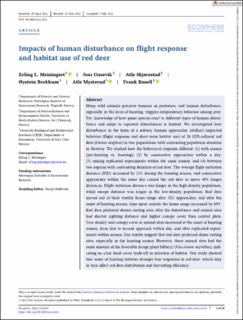| dc.contributor.author | Meisingset, Erling L. | |
| dc.contributor.author | Gusevik, Joar | |
| dc.contributor.author | Skjørestad, Atle | |
| dc.contributor.author | Brekkum, Øystein | |
| dc.contributor.author | Mysterud, Atle | |
| dc.contributor.author | Rosell, Frank Narve | |
| dc.date.accessioned | 2023-01-31T11:15:07Z | |
| dc.date.available | 2023-01-31T11:15:07Z | |
| dc.date.created | 2022-12-13T11:30:48Z | |
| dc.date.issued | 2022 | |
| dc.identifier.citation | Meisingset, E. L., Gusevik, J., Skjørestad, A., Brekkum, Ø., Mysterud, A. & Rosell, F. (2022). Impacts of human disturbance on flight response and habitat use of red deer. Ecosphere, 13(11), Artikkel e4281. | en_US |
| dc.identifier.issn | 2150-8925 | |
| dc.identifier.uri | https://hdl.handle.net/11250/3047354 | |
| dc.description.abstract | Many wild animals perceive humans as predators, and human disturbance, especially in the form of hunting, triggers antipredatory behavior among prey. Yet, knowledge of how game species react to different types of human disturbance and adapt to repeated disturbances is limited. We investigated how disturbance in the form of a solitary human approacher (stalker) impacted behavior (flight response and short-term habitat use) of 28 GPS-collared red deer (Cervus elaphus) in two populations with contrasting population densities in Norway. We studied how the behavioral response differed: (1) with season (pre-hunting vs. hunting); (2) by consecutive approaches within a day; (3) among replicated experiments within the same season; and (4) between two regions with contrasting densities of red deer. The average flight initiation distance (FID) increased by 15% during the hunting season, and consecutive approaches within the same day caused the red deer to move 49% longer distances. Flight initiation distance was longer in the high-density population, while escape distance was longer in the low-density population. Red deer moved out of their weekly home range after 52% approaches, and after the onset of hunting season, time spent outside the home range increased by 89%. Red deer preferred denser resting sites after the disturbance and animal sites had shorter sighting distance and higher canopy cover than control plots. Tree density and canopy cover at animal sites increased at the onset of hunting season, from first to second approach within day, and after replicated experiments within season. Our results suggest that red deer preferred dense resting sites, especially in the hunting season. However, these animal sites had the same amount of the favorable forage plant bilberry (Vaccinium myrtillus), indicating no clear food–cover trade-off in selection of habitat. Our study showed that onset of hunting initiates stronger fear responses in red deer, which may in turn affect red deer distribution and harvesting efficiency. | en_US |
| dc.language.iso | eng | en_US |
| dc.rights | Navngivelse 4.0 Internasjonal | * |
| dc.rights.uri | http://creativecommons.org/licenses/by/4.0/deed.no | * |
| dc.title | Impacts of human disturbance on flight response and habitat use of red deer | en_US |
| dc.type | Peer reviewed | en_US |
| dc.type | Journal article | en_US |
| dc.description.version | publishedVersion | en_US |
| dc.rights.holder | © 2022 The Authors. | en_US |
| dc.source.pagenumber | 14 | en_US |
| dc.source.volume | 13 | en_US |
| dc.source.journal | Ecosphere | en_US |
| dc.source.issue | 11 | en_US |
| dc.identifier.doi | https://doi.org/10.1002/ecs2.4281 | |
| dc.identifier.cristin | 2092472 | |
| dc.source.articlenumber | e4281 | en_US |
| cristin.ispublished | true | |
| cristin.fulltext | original | |
| cristin.qualitycode | 1 | |

